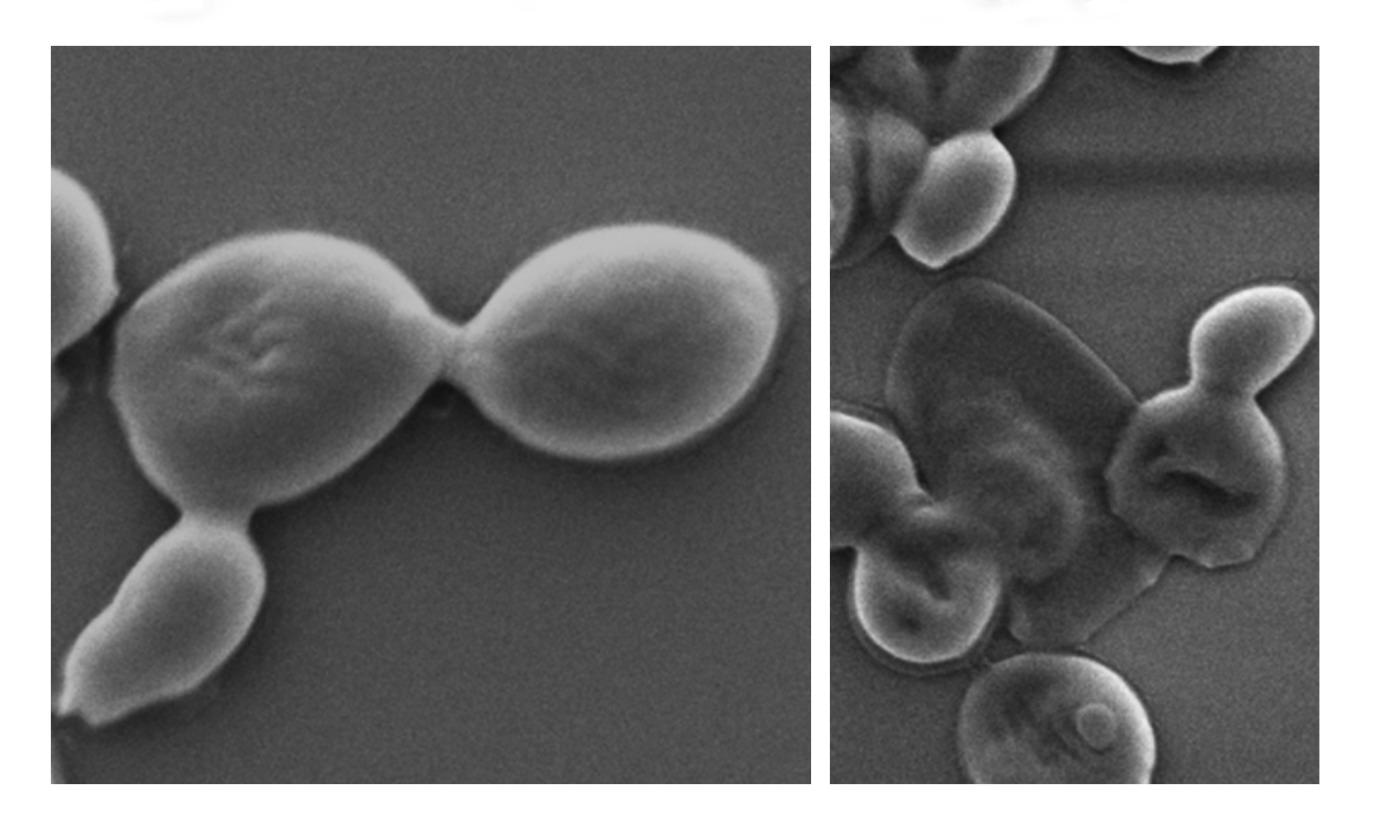Apr 15 2021
A new superbug-destroying coating developed by scientists could be utilized on implants and wound dressings to inhibit and treat potentially lethal fungal and bacterial infections.
 Candida auris fungus before exposure to ultrathin layers of black phosphorous (left) and after (right). Image Credit: RMIT Australia.
Candida auris fungus before exposure to ultrathin layers of black phosphorous (left) and after (right). Image Credit: RMIT Australia.
The material is considered as one of the thinnest antimicrobial coatings created so far and is powerful against an extensive range of drug-resistant fungal and bacterial cells but harmless against human cells.
Antibiotic resistance is considered a significant universal health threat, resulting in a minimum of 700,000 deaths annually. The lack of development of new antibacterial therapies could increase the death toll to 10 million people annually by 2050, which relates to $US100 trillion in health care charges.
The health care burden related to fungal infections is less recognized, but worldwide, they kill around 1.5 million people annually and the death toll is increasing. The common fungus Aspergillus is an emerging risk to hospitalized COVID-19 patients, for instance, which can result in deadly secondary infections.
Researchers from RMIT developed the new coating based on an ultra-thin 2D material that so far has primarily been of interest to next-generation electronics.
Analyses of black phosphorus (BP) have shown that it exhibits certain antifungal and antibacterial properties. However, the material has never been analyzed systematically for possible clinical use.
Published in the American Chemical Society’s journal Applied Materials & Interfaces, the latest study shows that BP is efficient at destroying microbes if it is spread in nanothin layers on surfaces such as cotton and titanium, which are used to manufacture wound dressings and implants.
Dr Aaron Elbourne, the study co-lead researcher, stated that determining one material that could inhibit both fungal and bacterial infections was considerable progress.
These pathogens are responsible for massive health burdens and as drug-resistance continues to grow, our ability to treat these infections becomes increasingly difficult. We need smart new weapons for the war on superbugs, which don’t contribute to the problem of antimicrobial resistance.
Dr Aaron Elbourne, Study Co-Lead Researcher and Postdoctoral Fellow, School of Science, RMIT University
“Our nanothin coating is a dual bug killer that works by tearing bacteria and fungal cells apart, something microbes will struggle to adapt to. It would take millions of years to naturally evolve new defences to such a lethal physical attack,” added Elbourne.
“While we need further research to be able to apply this technology in clinical settings, it’s an exciting new direction in the search for more effective ways to tackle this serious health challenge,” noted Elbourne.
Sumeet Walia, co-lead researcher and Associate Professor from RMIT’s School of Engineering, had earlier guided revolutionary studies with the help of BP for brain-mimicking electronics and artificial intelligence technology.
BP breaks down in the presence of oxygen, which is normally a huge problem for electronics and something we had to overcome with painstaking precision engineering to develop our technologies.
Sumeet Walia, Study Co-Lead Researcher and Associate Professor, School of Engineering, RMIT University
“But it turns out materials that degrade easily with oxygen can be ideal for killing microbes—it’s exactly what the scientists working on antimicrobial technologies were looking for. So our problem was their solution,” added Walia.
How the Nanothin Bug Killer Works
When BP disintegrates, it oxidizes the surface of fungal and bacterial cells. This process is called as cellular oxidization and eventually works to tear them apart.
In the latest study, study first author and PhD researcher Zo Shaw investigated the efficacy of nanothin layers of BP against five common strains of bacteria, such as Escherichia coli and drug-resistant MRSA, as well as five fungal strains, such as Candida auris.
Within two hours, up to 99% of fungal and bacterial cells were ruined. Significantly, the BP also started to self-degrade in that time and was completely broken down within 24 hours—an essential feature indicating that the material would not pile up in the body.
The laboratory analysis determined the maximum levels of BP that have a toxic antimicrobial impact while leaving human cells in a healthier condition and as a whole.
At present, the team has started experimenting with various formulations to investigate the efficacy of a variety of medically-relevant surfaces.
The researchers are eager to join hands with possible industry collaborators to further advance the technology, for which they have filed a provisional patent application.
Moreover, the RMIT research team included Sruthi Kuriakose and Dr Taimur Ahmed (Engineering); Samuel Cheeseman, Dr James Chapman, Dr Nhiem Tran, Professor Russell Crawford, Dr Vi Khanh Truong, Patrick Taylor, Dr Andrew Christofferson, Professor Michelle Spencer, and Dr Kylie Boyce (Science); and Dr Edwin Mayes (RMIT Microscopy and Microanalysis Facility).
Journal Reference:
Shaw, Z. L., et al. (2021) Broad-Spectrum Solvent-free Layered Black Phosphorus as a Rapid Action Antimicrobial. ACS Applied Materials & Interfaces. https://pubs.acs.org/doi/10.1021/acsami.1c01739.